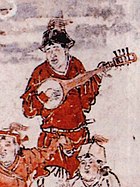Sarod
The Sarod is a stringed instrument, used mainly in Hindustani music on the Indian subcontinent. Along with the sitar, it is among the most popular and prominent instruments.[1] It is known for a deep, weighty, introspective sound, in contrast with the sweet, overtone-rich texture of the sitar, with sympathetic strings that give it a resonant, reverberant quality. A fretless instrument, it can produce the continuous slides between notes known as meend (glissandi), which are important in Indian music.[2][3]
Origins
Many scholars of Indian classical music believe that the sarod is a combination of the ancient chitravina, the medieval Indian rabab (aka the seniya rabab[4]) and modern sursingar. Some scholars even contend that a similar instrument may have existed about two thousand years ago in ancient India during the ages of the Gupta kings. In fact, a Gupta period coin depicts the great king Samudragupta playing a veena, which many believe to be the precursor of the sarod. The present Indian Traces of similar Rabab style instruments can also be found in southern India, especially in the states of Tamil Nadu, Kerala and Karnataka, where it is known as the swarbat. The folk rabab, an instrument popular in north India, had a wooden fingerboard, its strings were made of silk, cotton or gut, and it was played with a wooden pick. In history, reference is also made to a Sharadiya Veena from which the name Sarod have been derived. The sarod is also believed to have descended from the Afghan rubab, a similar instrument originating in Central Asia and Afghanistan.[5]
The word sarod roughly translates to "beautiful sound" or "melody" in Persian. Although the sarod has been referred to as a "bass rubab"[6] its tonal bandwidth is actually considerably greater than that of the rubab, especially in the middle and high registers. Lalmani Misra opines in his Bharatiya Sangeet Vadya that the sarod is a combination of the ancient chitravina, the medieval rubab and modern sursingar. Another instrument , the Sur-rabab, is known to exist, which has the characteristics of both the dhrupad rabab/seniya rabab and the sarod. The sur-rabab has the structure of the dhrupad rabab but has a metal fretboard and uses metal strings.
- ↑ "sarod · Grinnell College Musical Instrument Collection". omeka1.grinnell.edu. Retrieved 2019-10-13.
- ↑ "Classical Indian Musician Amjad Ali Khan to Perform March 1 at FAC". Office of News & Media Relations | UMass Amherst. Retrieved 2019-10-13.
- ↑ "ITC Sangeet Research Academy". www.itcsra.org. Retrieved 2019-10-13.
- ↑ "Sursringar.Org". www.sursringar.org.
- ↑ Miner, Allyn. 1993. "Sitar and Sarod in the Eighteenth and Nineteenth Centuries", International Institute for Traditional Music, Berlin.
- ↑ Courtney, David. "Sarod". David and Chandrakantha Courtney. Retrieved 2006-12-02.



